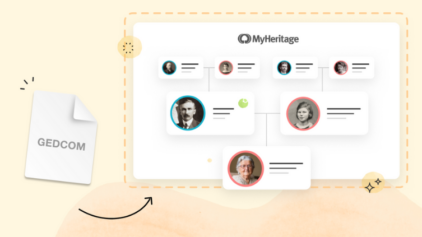How-in-the-world can I locate my adopted (without my knowledge) granddaughter? adoption agency is out of business and, even though I wrote many letters to be placed in her file, I don’t know where the files went after agency closure. I’m now 79 years old and may have little time left to find her. Your suggestions will be so very appreciated. Thank you,
Searching for Biological Relatives: From DNA Test to Reunion
- By Talya


 This is a guest post by Richard Weiss. Richard is the Executive Vice President and Director of Programs at DNAAdoption. He found his birth mother through a traditional search and birth father through a DNA search. He is an experienced genetic genealogist and adoption search angel. Richard is also on the advisory board for the MyHeritage pro bono project DNA Quest.
This is a guest post by Richard Weiss. Richard is the Executive Vice President and Director of Programs at DNAAdoption. He found his birth mother through a traditional search and birth father through a DNA search. He is an experienced genetic genealogist and adoption search angel. Richard is also on the advisory board for the MyHeritage pro bono project DNA Quest.
The search for a birth family or a family member given up for adoption is a challenging journey. Whether you are an adoptee or a birth family member, you are about to take a critical step on this journey of discovery by taking a MyHeritage DNA test.
We’ve divided the process into three phases. Phase 1: Taking the test and awaiting your results. Phase 2: How to understand the results and Phase 3: Contacting your relatives and organizing a reunion.
In this post, you’ll find our best tips and resources to help guide you through this journey. There is no way to determine how long your search will take, but with any journey, there are some steps you can take to increase the probability of success. Even if you have already completed some or most of the following steps, it can be beneficial to look at each step again in case something has changed since the last time you completed it.
Phase 1: Take the DNA Test and Awaiting Results
Step 1: Taking a DNA Test
When taking a DNA test, please reference the instructions included in the box or if you prefer, feel free to watch this video to get a step by step walkthrough of the process:
When you are finished with the test, please be sure to mail your sample to the MyHeritage DNA lab. From the time you send back your test, it will take 6 – 12 weeks for your DNA results to be posted.
Before receiving results, there are many things you can do to get ready.
Step 2: Request your non-identifying information (non-ID), Original Birth Certificate(OBC), or Adoption Record
Some of the key clues that you may need could come from information in the records that the state, country, or agency that processed the adoption. The information that is releasable to you varies by jurisdiction. Some states only allow release Non-Identifying (Non-ID) Information. Though Non-ID will not list names, even this information can be helpful. If you already have non-id, but it has been more than 3-5 years old, request it again.
Other states release the Original Birth Certificate (OBC) to the adoptee which may or may not list the names of the parents. The remaining states and some countries allow the entire Adoption Record, including the OBC to be released. What is releasable to birth family members also varies by state and country.
Because these are government or private agencies, it can take weeks or months to obtain the information, so it is best to submit your request as soon as possible.
If you are from the US, these links have information about what is releasable to you and how to get started:
- American Adoption Congress: https://americanadoptioncongress.org/state.php
- Adoption Institute: https://www.adoptioninstitute.org/wp-content/uploads/2013/12/openrecord_stateregistries_intermediary_programs.pdf
- G’s Reunion Registry is both a registry and a website that contains a comprehensive list of information about your state, province, or country. Registering with G’s Reunion Registry may connect you with search angels that have access to those resources. Here is a link: http://www.gsadoptionregistry.com/
- For those that prefer email, DNAAdoption provides a hidden, secret, and secure email group that can access those resources for free: http://groups.yahoo.com/group/DNAAdoption/
- Wikipedia maintains a partial list of Reunion Registries. In addition to registering with your state or country, you should register at as many of these as possible. Here is a link: https://en.wikipedia.org/wiki/Adoption_reunion_registry
- For those that prefer Facebook, you may want to consider joining the closed Facebook groups, Search Squad and DNA Detectives as they provide additional resources.
Please Note: Requesting your information may register you with the agency’s reunion registry. See the following step.
A Note About Offline Resources and Traditional Searches: There are offline information sources available for a number of states. These resources can be accessed through a traditional adoption search or some of the DNA support groups.
Step 3: Get registered
Sign up with Reunion Registries. Reunion Registries are forums that enable adoptees and birth family members searching for each other to quickly reconnect. This may be the fastest method for reconnecting. Most states in the US, as well as many countries, have reunion registries. There are also a number of private registries that you should sign up with as well. Sign up with every reunion registry that applies to you. Make sure to register with the state and/or country where your adoption took place, even if there is a fee.
Note: If you were born in one state or country and your adoption went through the court in another state or country, you should register in both places.
G’s Reunion Registry is both a registry and a website that contains a comprehensive list of information about your state, province, and country including Reunion Registries. Here is a link: http://www.gsadoptionregistry.com/
Wikipedia maintains a partial list of Reunion Registries. In addition to registering with your state or country, you should register at as many of these as possible. Here is a link: https://en.wikipedia.org/wiki/Adoption_reunion_registry
Step 4: Gather information from those who might know
An often overlooked source of information is family members and friends. They may have information about the circumstances surrounding the adoption. If they are willing, discuss the adoption with them making sure to note the details. These details may be helpful in determining where to look and who to look for.
Step 5: Learn about DNA and Genetic Genealogy
Using DNA with genealogy is called Genetic Genealogy. A DNA adoption search is a specialized use of Genetic Genealogy. The more you know about DNA and genealogy, the easier it will be to understand your results and use them for searching. Your MyHeritage DNA test is an Autosomal DNA test. It will be the primary test for your search. The time waiting on your DNA results is an excellent window to learn all you can about genetic genealogy.
We recommend starting your review with first learning about DNA:
- There are numerous articles on the MyHeritage blog about DNA in general, such as the DNA Basics series as well as articles on DNA matching.
- Beginners Guide to Genetic Genealogy: http://tinyurl.com/geneticgenealogyguide
- DNAAdoption is a non-profit organization that provides numerous free resources: www.DNAAdoption.org
- International Society of Genetic Genealogy’s (ISOGG) website: https://isogg.org/wiki/Beginners’_guides_to_genetic_genealogy
Step 6: Building your family tree
Learning how to build your family tree online will greatly enhance your ultimate DNA results.
MyHeritage provides help for building your family tree online. Please see here: https://www.myheritage.com/help-center#/path/Family-Site/Online-Family-Tree/
Should you decide that you’d like to grow your family tree, get access to numerous historical records and have access to unlimited smart matches, you may want to look into a Complete subscription.
FOR BIRTH FAMILIES THAT WANT TO BE FOUND: This is an opportunity to build your tree at MyHeritage. Making the tree public will help you to be found in as many places as possible. You can use a GEDcom file to export your tree for transfer from MyHeritage to other sites.
FOR ADOPTEES WITH ONE KNOWN PARENT: If you have a known parent, you should build a family tree for that parent at MyHeritage. If you have a good tree and can identify the DNA matches who match your known parent’s side, the ones who are left are most likely on your unknown parent’s side. The better this tree is, the easier your later searches will be.
Practice on the known people. If neither of your parents is known, practice on your adopted family or that of a spouse or in law. Anything you do to develop skills in genealogy will be useful later. Consult the research librarian at your local library and ask about the genealogy resources in your area. Ask about local classes on genealogy. Ask what genealogy subscriptions are available through your local library. Many libraries have free access to many genealogy sites such as MyHeritage. Some libraries even provide home access. Learn how to use their newspaper archives and find obituaries for people out of your adopted family.
See if there is a Family History Center run by the LDS Church near you. Family History Centers are free and open to everyone, members and non-members alike. They also have free access to many tree building sites and provide classes. And they will be happy to help you out. However, they are NOT adoption specialists. They can help you learn genealogy skills.
Step 7: Join a Genetic Genealogy Support Group
Support groups are places to go to get help and mentorship. Some are online, others may be local to your area.
Local Genealogical Societies can help you learn about genealogy as well as a DNA Interest Group, DIG.
There are also a number of online groups supporting adoption searches using DNA:
For those that prefer email, DNAAdoption provides a hidden, secret, and secure email group: http://groups.yahoo.com/group/DNAAdoption/
For those that prefer Facebook, DNA Newbies, Search Squad, and DNA Detectives are groups to consider.
Step 8: Search Angels
Search Angels are individuals who provide pro-bono (free) search support services. There are search angels that conduct “traditional” searches and search angels that specialize in DNA searches.
Search Angels can provide guidance, general information, and advice in groups. While they may prove helpful in answering questions, they will rarely take on sole responsibility for you. Some will help in the case of a medical emergency for example to need an immediate bone marrow transplant donor. If you get really stuck they may help you one-on-one and there are also those who are paid researchers.
Legacy Tree Genealogists is an affiliate of both MyHeritage and DNAAdoption that provides for-fee search services.
PHASE TWO: Getting Your DNA Results
To get started with reviewing your DNA Matches using MyHeritage, try out their recently updated Help Center specifically dedicated to DNA Matching.
Here are some of the guidelines on how to communicate with your matches:
http://www.dnaadoption.com/index.php?page=succeeding-with-autosomal-dna
The basic methodology is as follows:
A) Find your closest match.
B) Find the Most Recent Common Ancestor (MRCA) you share with the match using your Shared Matches and Pedigree Triangulation. Build your match’s trees “back” when needed
C) Build the MRCA’s tree “forward” into the present
D) Repeat for more matches
E) Determine where the descendants of these MRCAs intersect and connect
Step 9: Find Your Closest Match
Once you have opened your DNA results and looked at your ethnicity, it is time to move on to the information that will be the most helpful for your search, your matches. First take a look at your closest match. A very few of you may be extremely lucky and find a parent or the adoptee. Some of you may be lucky to find a very close match such as a sister, brother, niece, nephew, aunt, uncle, or grandparent.
FOR ADOPTEES: Capture all the information available about the match and build out their family tree completely. Your parent and possibly siblings will be in this tree. Turn to the support group you signed up with for help if needed. Then move to Phase Three: Contacting Your Relatives.
FOR BIRTH FAMILY: Capture all the information available about the match and move on to preparing for contact.
For most of you, the closest match may be predicted to be a 1st, 2nd, 3rd or 4th cousin. Keep in mind that most people only test at one company. If your closest matches are 1st, 2nd, 3rd or 4th cousins, it may be a good idea to see if you have a closer match somewhere else.
For those whose closest matches are 3rd and 4th cousins, you may be able to solve your quest with just pedigree triangulation. However, you may also need to use more advanced techniques that are not covered here. You will likely need to join a group like DNAAdoption for more help.
For those who only have distant matches, 4th cousin and further away, consider downloading your DNA from MyHeritage and uploading to a site such as GEDMATCH or Family Tree DNA to look for closer matches. You may need to use more advanced techniques that are not covered here or to join a group like DNAAdoption for more help.
To Download your DNA from MyHeritage:
1. First, download your raw DNA file from MyHeritage. Once you download it, do NOT open the file.
Note to Mac users: Ensure Safari is configured to not automatically open the file before starting.
Go to the following link and follow the instructions:
https://www.myheritage.com/dna/upload
2. Go to GEDMatch and register: www.GEDmatch.com
Log in, click on Generic Upload Fast, fill in the form and attach your file.
Next, go to this link at Family Tree DNA: https://www.familytreedna.com/autosomal-transfer
Once your transfer and processing have completed, check to see if you have a very close match. If so, follow the suggestions for close matches previously covered in this step.
Step 10: Pedigree Triangulation
The idea is to identify the common ancestors among your DNA matches. These common ancestors are likely (but not guaranteed) to be YOUR ancestors as well.
The methodology relies upon triangulation. The most basic form is called pedigree triangulation and the concept is pretty straightforward. Look at Figure 2 below. You match (share DNA) with Your Match. You also match (shared DNA) Shared Match. Your Match and Shared Match also match each other. That means the three of you most likely share a common ancestor. The goal is to find that common ancestor.
To find the common ancestor between your two matches, you need to compare the trees of both your closest match and the matches you share with him/her. You may have to open to tabs in your browser.
An example of comparing your match’s trees in pedigree view follows
Here is your Closest Match:
Here is a Shared Match. A Shared Match is the first match in the list of shared matches with Closest Match.
Both Closest Match and Shared Match have a tree
King and Queen are the great-grandparents of both Closest Match and Shared Match. King and Queen are their Most Recent Common Ancestor (MRCA). Closest Match and Shared Match are 2nd cousins (2C).
NOTE: Relationship predictions are also a key factor to consider.
Relationships predictions include a range of possibilities. With the exception of parent/child, they are not exact.
In this example, Closest Match is predicted to be your 1st Cousin Twice Removed (1C2R) to 2nd Cousin Once Removed (2C1R). Shared Match is predicted to be 1st Cousin Twice Removed (1C2R) to 2nd Cousin Once Removed (2C1R).
The predicted relationships you have with your two matches along with their actual relationship indicate that the King and Queen are likely to be your ancestors.
Now that you have found the MRCA for this group of matches, repeat the process for the next closest match that is not in the list of shared matches with your closest match.
You may have to identify a number of MRCAs before moving on to connecting your trees.
More on the concepts of pedigree triangulation can be accessed from the MyHeritage blog on their Chromosome Browser.
NOTE: The previous example is provided to help develop an understanding of the concepts and methods of pedigree triangulation. There are many factors and variables not discussed in this example. Support groups are a great source of help in understanding these concepts.
If your match doesn’t have a tree to refer to, you may need to contact your match and ask for their grandparents or great-grandparents’ names or if they have a tree somewhere else that you can look at to find your common ancestor. Do not mention adoption. Support groups can be a great source of help in crafting messages to your matches.
NOTE: Contacting Distant Matches/ Advanced Techniques
Some of you may only have distant matches (4th cousin and further). In addition to using pedigree triangulation, you likely will need to use more advanced techniques that are not covered here. You very likely will need to join a support group like DNAAdoption for more help.
DNAAdoption for a small fee offers classes the cover these advanced techniques.
Step 11: Connecting Trees
Common Ancestors have descendants. Descendants of different common ancestors that had connected, often married, is the next step.
Once you have a common ancestor identified, use your research tree to build a descendant tree: a tree of all the descendants of the ancestor. You will need to switch from Pedigree view to Family view to be able to see the descendants at each generation.
As you identify other common ancestors, build their descendant tree into your own research tree. As you identify more MRCAs and build your descendant tree, keep looking to see where a descent from one common ancestor connected with a descendant of another common ancestor.
PHASE THREE: Found or Been Found: Contact and Reunion
Step 12: Preparing for Contact
Making contact is a very emotional experience. It is best to have support and not attempt this alone. Help and support are available from reputable and experienced groups like Concerned United Birth Parents, First Mother’s Forum, DNAAdoption, and the American Adoption Congress. Working with these organizations will greatly improve your probability of a positive outcome and help you avoid the common pitfalls that can ruin an opportunity for a reunion or even obtaining medical and family history information. DNAAdoption and Adoption.com have some key considerations to address before attempting contact.
Step 13: Initial Contact
It is highly recommended you get help with this step. Those who try this alone reduce the possibility of a positive outcome. Once you have identified the person you are looking for, you need to find their contact information and develop and send your first message. Groups like DNAAdoption, Search Squad, and DNA Detectives can help you with identifying the contact information. Concerned United Birth Parents, First Mother’s Forum, DNAAdoption, and the American Adoption Congress have first contact guidance that if followed increases the opportunity for a positive outcome.
Step 14: Reunion
Reunions are filled with much anticipation, excitement, and fear. At their heart, reunions involve two strangers who are closely related. It is a very emotional event and should be approached with much care and consideration. To prepare for your reunion, you can check out some great articles on First Mother’s Forum, the American Adoption Congress, and Adoption.com have some suggestions.
Utilizing help from reputable and experienced professionals may benefit.
Summary
The journey towards finding your biological family can be fraught with many ups and downs that can make for quite a challenging experience. Whether you are an adoptee or a birth family member, using a MyHeritage DNA test, is a great starting point to your quest.
We hope this guide provides you with enough resources and ideas to help guide you along the way.















Richard Bolef
August 1, 2018
My name is Richard Bolef – probably not my birth name. I was born in New York City in 1953 and was given up for adoption at birth.
The only thing I know is that my birth parents were not married, my mother was still in high school, and she had German measles, which is why I was born profoundly deaf. My native language is American Sign Language. I am having this interpreted into English.
This is probably an impossible task, but if anyone knows of a child that fits this information, please contact me.
Thank you,
Richard Bolef, 7223 Sapphire Avenue, Jennings, Missouri 63136